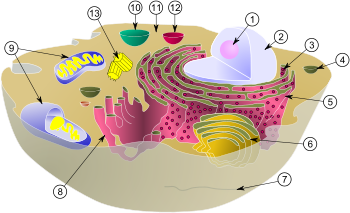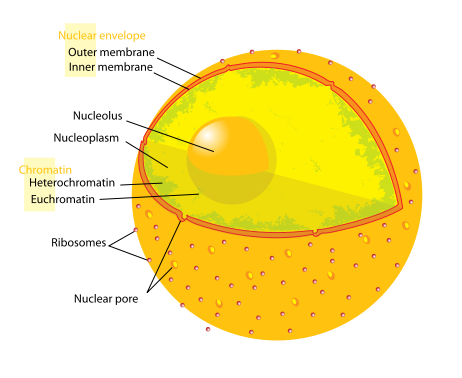Nucleus
The nucleus is the most obvious organelle in any eukaryotic cell. It is enclosed in a double membrane and communicates with the surrounding cytosol via numerous nuclear pores. Within the nucleus is the DNA responsible for providing the cell with its unique characteristics. The DNA is similar in every cell of the body, but depending on the specific cell type, some genes may be turned on or off – that’s why a liver cell is different from a muscle cell, and a muscle cell is different from a fat cell. When a cell is dividing, the nuclear chromatin (DNA and surrounding protein) condenses into chromosomes that are easily seen by microscopy.
The nucleus also contains the nucleolus which helps to synthesize ribosomes. The nucleolus contains nucleolar organizers which are parts of chromosomes with the genes for ribosome synthesis on them. Copious amounts of RNA and proteins can be found in the nucleolus as well.
The main structural elements of the nucleus are the nuclear envelope, a double membrane that encloses the entire organelle and keeps its contents separated from the cellular cytoplasm, and the nuclear lamina, a meshwork within the nucleus that adds mechanical support much like the cytoskeleton supports the cell as a whole. Nuclear transport is of paramount importance to cell function, as movement through the pores is required for both gene expression and chromosomal maintenance.

Schematic of typical animal cell, showing subcellular components. Organelles:
- nucleolus;
- nucleus;
- ribosome;
- vesicle ;
- rough endoplasmic reticulum (ER);
- Golgi apparatus;
- Cytoskeleton;
- smooth ER;
- mitochondria;
- vacuole;
- cytoplasm;
- lysosome;
- centrioles.
The main function of the cell nucleus is to control gene expression and mediate the replication of DNA during the cell cycle. The nucleus provides a site for genetic transcription that is segregated from the location of translation in the cytoplasm, allowing levels of gene regulation that are not available to prokaryotes.
Structure
The nucleus is the largest cellular organelle in animals. In mammalian cells, the average diameter typically varies from 11 to 22 micrometers (μm) and occupies about 10% of the total volume. The viscous liquid within it is called nucleoplasm, and is similar to the cytoplasm found outside the nucleus.
Nucleolus
The nucleus is the ‘control center’ of a cell. It contains the cell’s hereditary information (DNA) and controls the cell’s growth and reproduction. The nucleus also controls the synthesis of ribosomes and proteins in the cytoplasm.Nucleolus: The prominent structure in the nucleus is the nucleolus. The nucleolus produces ribosomes, which move out of the nucleus and take positions on the rough endoplasmic reticulum where they are critical in protein synthesis.
The main role of the Nucleolus is considered to be ribosome biogenesis, since its fundamental component DNA codes for preribosomal RNA.
Additionally, recent research pointed out that the nucleolus is also responsible for the trafficking of various prominent small RNA species. The nucleolus helps them during their maturation process and route to their final cellular destination. Moreover, although nucleoli become invisible during cell division, more recent studies have found that they are involved in cell cycle regulation. Several of its non-traditional roles include interaction with viral components, the regulation of tumor suppressor and oncogene activities, signal recognition particle assembly, the modification of small RNA strands, the control of aging and modulating telomerase function.
